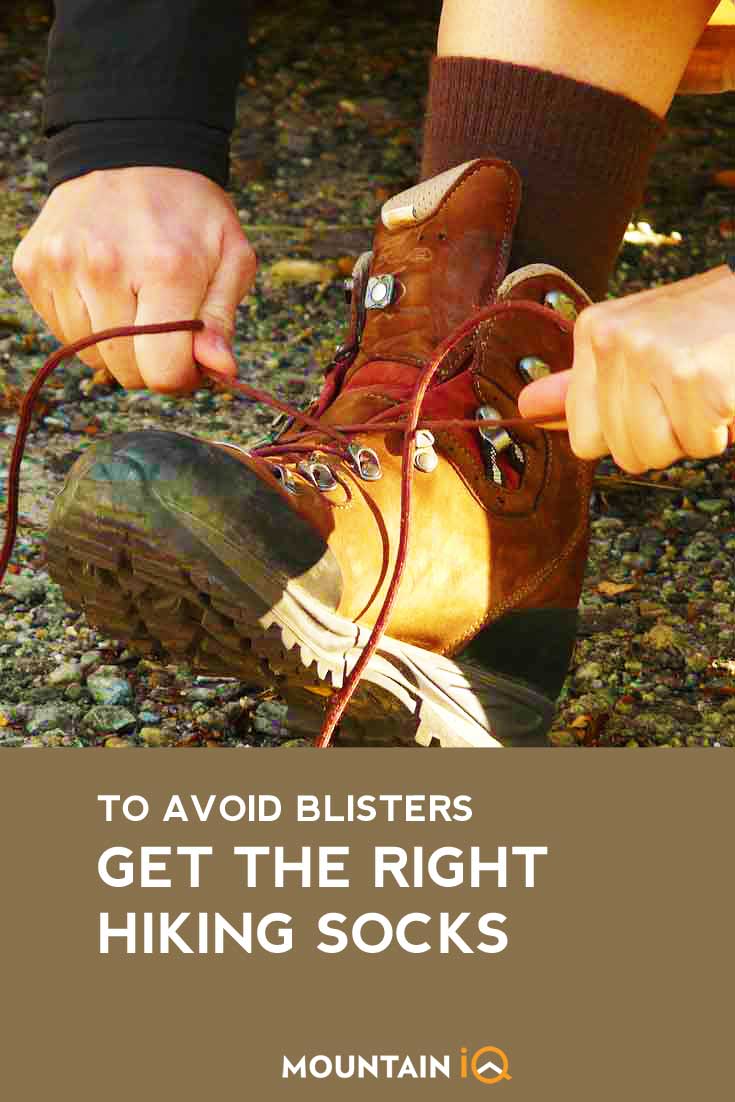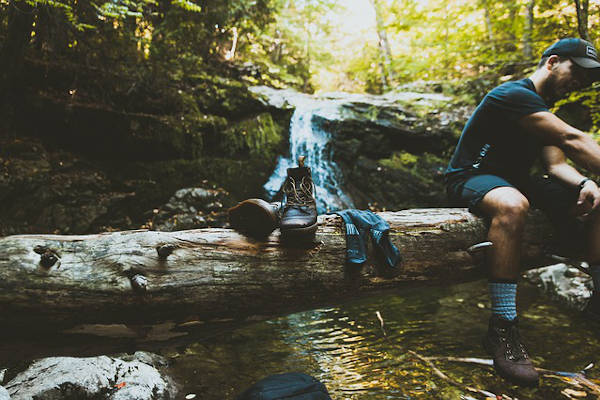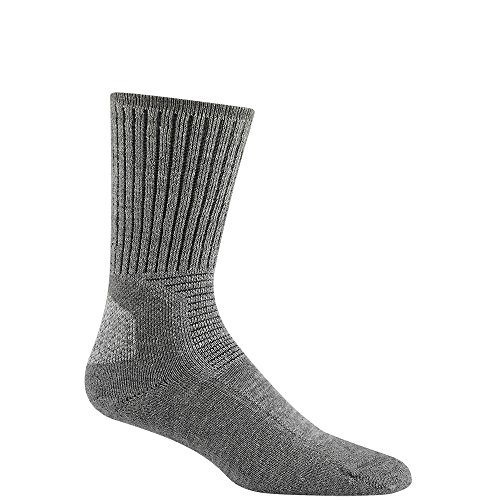For a great quality merino wool sock, I recommend Darn Tough Hiker Full Cushion.
If your feet sweat quick a bit while hiking then I recommend the Avoalre High Performance Athletic Socks for their awesome moisture wicking properties.
Below are more of my top picks for the best hiking socks to make trekking a cinch.
Best Hiking Socks (Top Picks)
Best Overall
Most Comfortable
This article contains affiliate links. If you buy something through the links on this page, we might get a small commission. It will not affect your price but helps keep our site alive!
Top Hiking Socks (Detailed Reviews)
We reviewed over 18 hiking socks for this article. Below are the best hiking socks that made our short list.
- Darn Tough Hiker Full Cushion - Best Overall
- Avoalre Athletic Socks
- Smartwool PhD Outdoor Light Crew - Best Lightweight
- Farm to Feet Damascus
- Danish Endurance Merino Wool Hiking Socks - Best Value
- Wigwam Hiking Outdoor Pro
Read our complete buyers guide for the best hiking socks.
Best Overall Hiking Socks
1. Darn Tough Hiker Full Cushion
Together with warmth and comfort, the Darn Tough Hiker boasts a myriad of benefits, including durability and versatility. The lifetime guarantee gives great value for money with the Merino Wool’s staying power, regardless of terrain.
Darn Tough lives up to its name as the lifetime guarantee gives seasoned hikers something to trust in. The comfortable fit makes this sock good for three-season activity.
Rated the best overall sock, the construction provides you with various comforts for your hike, while the elasticity around the arch provides a snug fit. No need to worry about bunching.
The pitfall, however, is that due to its snug tight fit the degree of breathability can be restricted.
Check Prices
Main Features
What we like
What we dislike
Key Takeaway
The lifetime guarantee gives you peace of mind that the durability and construction of the Darn Tough Hiker Full Cushion socks goes the extra mile, for your extra miles.
2. Avoalre Athletic Socks
The Avoalre athletic socks are my go-to-option for general athletic socks.
I really like them as they are a super comfortable, lightweight and versatile sock. They perform well across various sporting activities, including running, going to the gym, and hiking. They are also very affordable, which is a big bonus for me as I'm very budget conscious.
The socks are made from a combination of materials: 30% Coolmax, 30% Cotton, 35% Nylon, and 5% Lycra. The Coolmax material really helps with the moisture-wicking properties, but they are obviously not as efficient as full wool socks. That being said, the nylon means they are much more durable than natural materials and you don't get much of an odour problem with them.
Main Features
What we like
What we dislike
Key Takeaway
The Avoalre athletic socks are made with an efficient Coolmax wicking moisture fabric to keep your feet comfortable and odour-free on long and strenuous treks. However, if you have bigger or wider feet, I recommend you buy a larger pair than your actual foot size to compensate for the Avoalre's less-than-ideal snug design.
3. Smartwool PhD Outdoor Light Crew
Smartwool’s PhD provides hikers, trail runners and backpackers with sufficient cushioning under the heel and forefoot. The material is more lightweight in comparison to Darn Tough.
The new knitting technique used in the Smartwool sock provides more durability in the material, for the long haul. Moreover, the construction of the wool-based material gives you good value for money, balancing: function, form and fit.
This sock is rated as the best lightweight hiking sock. There is a cozy feel to the sock and capacity to perform in three season conditions. There is also looser women’s specific fit to the design.
Check Prices
Main Features
What we like
What we dislike
Key Takeaway
As far as lightweight socks go, the Smartwool PhD range is an excellent choice. The sock is versatile for various activities and the mix of materials helps you put your best foot forward.
4. Farm to Feet Damascus
These Farm to Feet Damascus hiking socks work well in cool climates and are made to manage moisture effectively. The design compliments hiking shoes and boots.
The benefits of the Farm to Feet Damascus lies in its comfort and breathability. It is however, not suited for hot weather.
The components that add to this sock’s comfort level include: fit, thickness, cushioning and areas of compression. It is understandable that a gender neutral option like this one makes all hikers happy.
Main Features
What we like
What we dislike
Key Takeaway
If you're looking for great breathability and comfortable cushioning socks, then you can't go wrong with the Farm to Feet Damascus range.
5. Danish Endurance Merino Wool Hiking Socks
The Danish Endurance Merino Wool hiking socks are a great option for those on a tight budget.
The sock is made from 33% Merino Wool, 33% Acrylic, 33% Polyamide and 1% Elastane. This makes it great for breathability airflow to prevent moisture build from sweat.
The sock also comes with additional cushioning in high impact areas.
The one negative though is related to comfort. As the material is heavily synthesized with wool, the sock doesn't feel very soft and it may take a few washes for it to soften up.
Main Features
What we like
What we dislike
Key Takeaway
This budget-friendly Danish Endurance Merino Wool hiking sock will keep you dry and warm throughout your hike, but don't expect a super comfortable feel.
6. Wigwam Hiking Outdoor Pro
Wigwam are market leaders in the synthetic hiking sock industry, and with the Wigwam Hiking Outdoor Pro they have really upped the ante.
The Outdood Pro sock is a midweight / mid-calf sock that is suitable for all types of outdoor adventures. The sock is heavily cushioned for comfort under the foot, and includes a reinforced heel for added durability and long wear.
There is a lightweight instep for enhanced breathability and the patented Wigwam Ultimax moisture management system ensures sweat escapes the foot with ease.
With a lifetime product guarantee, you can't go wrong with the Wigwam Outdoor Pro hiking sock.
Main Features
What we like
What we dislike
Key Takeaway
As far as synthetic hiking socks go, Wigwam are our preferred choice and with the Outdoor Pro range - they don't disappoint.
Hiking Socks - Buyer's Guide (Key Features)
These are a few essentials considerations to help you find the right sock for your particular hiking needs.
Material
The fundamentals of hiking sock materials lies in its capacity to be breathable, for the fabric to prevent absorption of moisture, and to provide adequate insulation when temperatures change.
The dominant material used in these socks is Merino Wool. The benefit of this material lies in its capacity to regulate temperature, thereby keeping unnecessary moisture at bay. The wool is more durable and has longevity. The insulation that the sock provides keeps your feet warm and dry, throughout your trek. Merino wool ensures cushioning, breathability and solid fit on your foot so that your journey is not disrupted by bunching or socks losing their grip.
The blends of material that are in the socks mentioned in this review helps in the sock’s versatility. Nylon draws moisture away from one’s foot; Acrylic minimises absorbency with its synthetic make-up, whereas Spandex and Elastane brings about a good fit with an elastic component.
The Olefin material, characteristic of the Wigwam Hiking Outdoor Pro, has similar properties of: fit, warmth and comfort to protect your foot while hiking.
Height
Gaiters generally come in three height options:
1. Low: The shortest, over the ankle option is ideal for trail runs or light hikes. Their function primarily to keep trail debris out.
2. Mid calf: A mid-calf option offers the best of both worlds, providing additional protection in denser foliage or shallow river crossings.
3. Knee High: The tall gaiter is designed for rugged terrain, deep snow and wet brush.
Thickness and Material Weight
When considering the preferred thickness, it is helpful to understand the purpose of varying thickness that you can get. The thickness provides your foot with cushioning that protect your feet during high impact activities.
The medium thickness of these five socks suits the terrain of hiking and acts as a versatile option for varying conditions in which one may hike.
Socks are categorised into different material “weights” or thickness in order to suit specific activities.
In the comparison table above, three of the five socks are categorised as: Midweight. This category is best suited for hiking and backpacking because there is more cushioning where it matters most - the heel and forefoot.
This added cushioning provides comfort for longer trips and cold to warm weather. The Lightweight category that Farm to Feet Damascus falls under, is suited for breathability in warm to cool weather, and preventing moisture from collecting on the foot.
Durability
When embarking on a hike, one needs a sock that is going to endure the conditions of the terrain. As mentioned above Merino Wool socks have sufficient cushioning that assists with the material’s durability. The tightly woven fit and length of the sock accommodates hiking boots and the intensity of the activity.
Synthetic and blend materials also have a degree of durability to them and aim to bring together the best of the combination of materials to suit a hiker’s needs.
In order to minimise breakage and unnecessary stretch the combination of Spandex and Elastane reinforces the strength of the fabric and maximises the fit.
One would not want to sacrifice performance with blisters and bruises and the socks in this review are designed to provide comfort, endurance and longevity.
Sock Length and Warmth
The length of most hiking socks taper off at the midcalf and are understood to be crew style. The benefits of the length assist with shin protection and if the sock is above your hiking boots you lessen the risk of chafing and blisters.
The length of the sock also aids in understanding whether the fit suits the particular activity you are going to be doing.
Socks that are taller offer better protection and warmth and work hand-in-hand with hiking boots. Shorter socks do not offer as much protection and are better suited for hiking shoes, and activities like: trail running or mountain-biking.
You are more than likely going to be tested in adverse weather conditions and the warmth of your toes in your boots should not be compromised. The key thing is to recognise that a sock’s versatility in terms of drying time and adaptability needs to be on your criteria.
It is helpful to note that socks that keep you warm whether they are wet or dry, shows its adaptability with differing hiking climates. Merino Wool provides good warmth and regulates temperature well.
Breathability
When embarking on a hike, one would like that peace of mind that the socks you choose are going to provide sufficient airflow to your feet because.
If a sock has breathability panelling you can rest assured that the moisture will not be retained in the sock but that your foot will be kept dry and warm, particularly in colder conditions.
Thicker materials might not provide as much breathability as a lightweight material. Merino Wool does breathe better than synthetic options so all the bases are covered.
A sock’s capacity for wicking is also something worth noting because one needs a sock that draws moisture away from the foot.
A variety of weather conditions requires that a sock be versatile enough to keep you warm in cooler temperatures and cool in hotter temperatures. The socks available in this review have the capacity to adapt to the weather variations as your hike progresses.
Continue browsing
See more gear reviews and our detailed outdoor clothing gear guide. Or check out these reviews:








